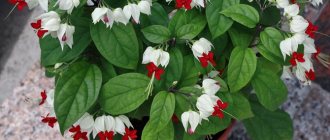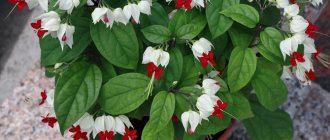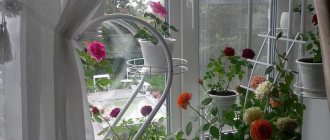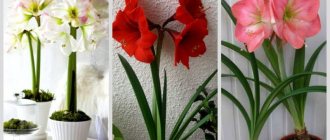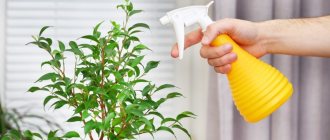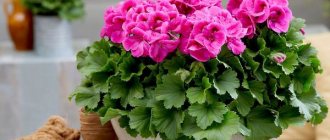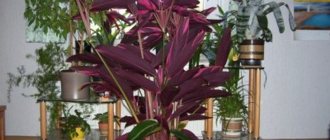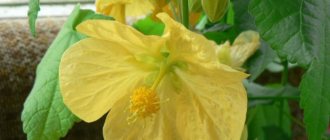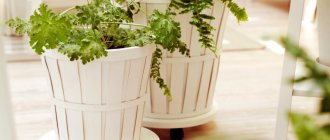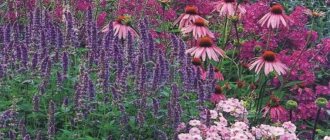Names of purple indoor flowers
The purple color of the petals looks advantageous in a classic or minimalist interior; such plants always attract attention. There are many varieties of domestic crops with light or dark purple buds. And each of them requires proper care and attention. In this case, the flower will delight you with flowers all year round. If you do not provide the plant with comfortable growing conditions, it stops blooming and eventually dies.
Himalayan geranium. The shrub plant reaches only 30-60 cm in height. It is distinguished from other species by large flowers with lilac petals of varying degrees of brightness (from light lilac to rich, with pinkish veins).
Standard care:
- moderate air temperature (tolerates both heat and coolness, but only for a short time);
- diffuse lighting;
- draft protection;
- watering 2-3 times a week, depending on the time of year.
Achimenes Ehrenberg. Reaches half a meter in height. It has straight and thin stems on which grow medium-sized leaves with a bright green color and clearly visible veins. The flowers are purple at the edges and deep lilac closer to the center. The flowering period occurs from the beginning of spring to the end of autumn.
Saintpaulia. There are many varieties of the plant. They all differ from each other in the color of their buds. They are terry or glossy, light lilac or bright purple. Plants with a heterogeneous shade that combines several colors at once (duochrome, chimera, bordered) look unusual. Saintpaulia grows up to 30 cm in height, has thin stems and a shallow root system. Roots well in loose soil mixed with sand.
Gloxinia. The plant has a tuberous root system, thin stems surrounded by double green leaves. Buds with a diameter of 5 cm bloom at the tops of the stems. They are distinguished by their border color - white at the edges and dark lilac in the center. The shape of the petals is wavy, heterogeneous. Flowering occurs in the summer and lasts 2-3 months.
Calla purple. It has the same structure of stem, leaves and flowers as the classic white variety. A distinctive feature of the plant is the deep purple hue of its petals. The color is uniform, inclusions of other colors are rare, which depends on the type of crop.
Passionflower. An exotic plant, notable for its unusual flower shape. The petals are painted in different shades of lilac. In one inflorescence there are light and rich tones. In the middle there is a corolla, which consists of bright purple threads, and a yellow anther. The leaves have a complex shape with jagged edges. The stem is thin, growing upright.
Stapelia shaggy. The plant belongs to the category of succulents. It has strong and fleshy leaves, thick stems in which moisture accumulates. Buds form at the tops of the stems, which then bloom into bright purple, star-shaped flowers. The flower is double, covered with barely visible fibers. Some varieties have light veins on the petals.
Streptocarpus. Dark terry leaves of a green hue are collected in a basal rosette. Stems rise from it to a height of 20-30 cm, and on their tops purple, funnel-shaped flowers with white veins and a light center are formed. The buds reach 5-7 cm in diameter.
Fuchsia. An evergreen exotic plant with thin green branches-stems on which bright purple flowers of unusual shape bloom. They have a corolla-shaped cup and a tube-shaped corolla. The surface of the petals is terry or simple. The flower is easy to care for, but in winter it needs rest.
Under the wrong conditions, the flowers first change color, become dull, and become covered with spots. The emergence of such a situation indicates that it is necessary to reconsider the care of the crop.
Indoor blue flowers
It seems that in one room with blue flowers you can even breathe easier. And how amazingly good they are!
Browallia
Specifically, the browallia is beautiful. And the name of this lush fluffy bush speaks for itself. Dozens of bright blue stars bloom on dark green leaves.
Photo: zooclub.org.ua
Agapanthus
The exotic lily is quite capricious, but it will perfectly decorate the room throughout the summer and autumn. Blue and light blue umbrella inflorescences emerge from fluffy leafy rosettes.
Photo: u-florista.ru
Pig
Pig requires proper storage and temperature conditions in winter. But her adorable blue and blue brushes are definitely worth it. By the way, this is actually a liana, and with proper care, it grows quickly.
Photo: kartinki-cvetov.ru
Campanula
The charming bells of Campanula look even more touching when combined with heart-shaped leaves. The plant needs to be rejuvenated every few years, but it blooms almost all this time.
Photo: pulse.mail.ru
Ageratum
Blue and blue ageratums have long been not uncommon. Small fluffy flowers resemble homemade dandelions. Moreover, a lot of stems diverge from one bush.
Photo: oir.mobi
Gloxinia
Among the dozens of varieties and species of gloxinia, there are many blue flowers. They have large and sometimes simply huge bells of one or several shades.
Photo: fanil-latypov.blogspot.com
Primrose
Blue primrose is distinguished by early, long-lasting flowering and a wonderful aroma. In general, this is a very versatile plant that can be grown on a windowsill, on a balcony, in outdoor containers and in the garden.
Photo: kartinki-cvetov.ru
Indoor crocus
Yes, yes, this primrose can be safely grown on a windowsill. They thrive in groups in a wide container and fill a period when little else is blooming.
Photo: townsendlandscape.com
Clitoria
It is from this that the most famous blue tea in the East is prepared, and what else can be added? Natural blue dye is also extracted from it. There is only one drawback - the capricious clitoris is unlikely to suit beginners.
Photo: pinterest.ie
paniculate phlox
Among the bright and colorful phloxes, there are deep blue varieties. The plant blooms so profusely that it seems as if the bush consists entirely of buds.
Photo: domashniecvety.ru
Eustoma
Indoor eustoma or lisianthus also come in all possible and impossible shades. There are also blue-blue or blue-violet varieties among them.
Photo: mobilemusic.ru
Cineraria
Countless hybrid cineraria varieties are at your disposal. Ultramarine blue flowers with a white center are especially good.
Photo: hanaenet.com
Achimenes
The blue flowers look even brighter against the bronze and burgundy foliage. Achimenes thrives in flowerpots and hanging planters.
Photo: vse.kz
Streptocarpus rex
The eternal love of many gardeners, because despite all the visual fragility and tenderness, streptocarpus is not too capricious. Its light blue petals with darker veins are especially beautiful.
Photo: m.nn.ru
What house plants have this leaf color?
Gardeners also prefer to grow plants that have unusual lilac or purple leaves. There are many varieties of such flowers. They fit well into the design of the house and are considered original due to their appearance.
Hemigraphis. An evergreen plant with lilac foliage. At home, 4 varieties of hemigraphis are grown from a wide variety of species:
- Widely pitted. Reaches 20 cm in height; root nodes are placed on thin creeping stems, thanks to which the plant easily takes root in nearby areas of soil. The lanceolate leaves are purple with a hint of green above and red-purple below.
- Alternate. Brown stems-shoots spread along the ground, their nodes take root in the soil, giving life to new shoots. The leaves are heart-shaped, brownish-purple.
- Color. Curly greenish shoots, wrinkled leaves on top are painted in a violet-blue hue with an admixture of silver.
- Exotic. Thin stems firmly cling to support, so this variety is suitable for decorating various surfaces. The small leaves above are lilac-colored with green splashes, and below they are reddish.
Ginura. Lush fast-growing shrub with small lilac leaves. The stems are creeping or upright (depending on the variety), grow 50 cm in length, hollow inside. The leaves are colored deep purple at the bottom and have bright green veins on top. They are covered with light fluff, giving them a spectacular terry surface.
Zebrina. The leaves of the plant are pointed, they are bright purple below, covered with light whitish stripes above. Hence the name of the flower. Depending on the variety, the stems droop or grow upward.
Irezine. An exotic crop belonging to the amaranth family. This herbaceous, shrub or semi-shrub plant is unpretentious in care, so many of its species take their place of honor in the homes of flower growers.
The following varieties are considered popular:
- Herbst;
- Purple Lady;
- Linden.
Oxalis. An annual or perennial plant with small compound leaves that are curved on the outside. Their distinctive feature is a red-violet hue. The leaf rosettes are shaped like feathers or paws. The culture grows quickly and takes root in moderate conditions and with minimal care.
Reo multi-colored. A distinctive feature is the shape of matte, durable leaves. They resemble triangles connected at the tops. The color of the foliage above is rich green, below is bright purple.
With improper care or improper maintenance conditions, the color of the leaves gradually changes. If you notice this situation, try to reconsider your care and water the plant more often.
Lilac and purple perennials for the garden
Garden flowers of noble purple shades have a magical appeal - they combine the calmness of blue and the energy of red. Among them there are annuals and perennials, so there are many options for use in landscape design.
Ageratum Houston (Houston) or Longflower (Ageratum Houstonianum)
The herbaceous perennial is characterized by long and abundant flowering - the flowering period lasts from the beginning of June until frost. Hence the second name - “long-flowered”. Goes well with any annuals and low-growing perennials.
Upright stems, depending on the variety, reach 15-50 cm in height. The wrinkled, bright green leaf is jagged and triangular in shape. Small tubular fragrant flowers are collected in small (1 cm) baskets, which form a fluffy inflorescence-scutellum about 10 cm in diameter. “Fluffiness” is imparted by elongated stigmas that match the color of the flowers. Seed ripening begins in August-September.
Varieties with lilac flowers: Blaue Kappe, Blie Mink, Fire Pink (dark pink flowers, lilac buds).
Astra perennial
Perennial asters occupy a leading position among flowering plants. Elegant, varied in color, ideally combined with other crops, frost-resistant, unpretentious - that's all about them. You can choose varieties with different flowering periods, and the flower garden will be bright and decorative from spring to late autumn.
Alpine asters bloom in the spring, daisy asters in the summer, and in the fall comes the turn of the New Belgian, New England, and shrub ones. Dahlias, ornamental grasses and cereals, echinacea, and sedum will make excellent company for them.
Related article:
Ivy plant: photos, types, cultivation, planting and care
Varieties of different shades of purple:
- A. alpine – Blue Star, Violetta, Illyria, Goliath, Sabine, Superbus
- A. Italian – Coerulea, King George, Kobold;
- A. sedum-leaved – Nanus;
- A. bush – Blue Laguna, Duncle Schone, Dwarf Nancy, Lazurit;
- A. novobelgian - Bengale, Royal Velvet, Purple Dom, Sara Ballard, Marie Ballard, Sunset;
- A. New England - Bars Pink, Browmann, Constance, Doctor Eckener, Glorie de Kronstadt, Purple Dome.
Delphinium
Garden forms of perennial delphinium are, most often, hybrids, with a height of 80 to 200 cm. The stem is rigid, straight, and does not branch. The serrated, beautiful, feathery leaves form a rosette. All the beauty of the delphinium is in the long, sometimes reaching 1 m, apical inflorescence, consisting of large (4-6 cm) flowers. Flowering lasts from June to July. They look impressive in groups of the same color, in compositions with flowers of warm shades.
Hybrid varieties: lilac Сameliard, terry purple Sweet Sensation, dark purple Black Night, King Arthur, Ajax, King Arthur, Black Knight.
Oregano or oregano (Origanum vulgare)
Unpretentious oregano, planted in monochrome groups or in composition with deciduous plants, looks gentle and charming, despite its “simplicity”. The erect stem is slightly pubescent, strongly branches in the upper part, and grows from 50 to 70 cm in height. The oblong leaf (1-4 cm) is pointed at the tip, has slight pubescence, and is darker at the top than at the bottom. Small flowers form a corymbose-paniculate inflorescence. Does not grow well in acidic and clay soils. Reaches maximum decorative effect in well-lit areas.
Related article:
Three plants suitable for every home
Decorative varieties:
- Rainbow - has medicinal properties, the height of the bush is 60-70 cm, the flowers are very fragrant, the buds are rich purple, the leaves are bright purple;
- Beauty Kent – drooping stems, flowers collected in a small brush, the inflorescence contains lilac and white shades;
- Herrenhausen is a variety of German selection, purple inflorescences, blooms in the second half of summer.
Clematis
Luxurious clematis will decorate any area - space, and not much of it is required, can always be found for vines. Clematis bloom profusely and for a long time, surprising with the variety of shapes and colors of inflorescences, leaves, and flowers. Depending on the variety, the length of the stems reaches 90-250 cm.
Varieties:
- Arabella is a winter-hardy variety with large blue-violet flowers, about 2 m high, blooms from June to September;
- Ashva - suitable for the climate of the middle zone, the flowers are large, flat, purple-violet, height - up to 2 m;
- Astra Nova - petals are purple along the edge, white in the center, does not tolerate frost without shelter, stems grow up to 2.5 m;
- Ball of Flowers - the variety is not frost-resistant, the petals of a delicate lilac color are wide at the base, blooms in June-July and August-September;
- Baltyk - a variety with purple flowers, most decorative in openwork partial shade;
- Copernicus – winter-hardy, shoots no more than 2 m long, double flowers, purple, blooms from June to September;
- Daniel Deronda - a variety for warm climates, flowers with blue-violet petals, double or semi-double, stem length - up to 2 m;
- Jackmanii is winter-hardy, the stems reach a length of 4 m, the flowers are purple, the flowering period is from July to October;
- Gabriel Narutowicz – lilac-violet variety, poor frost resistance, height – up to 2 m;
- Gisela – shoots no higher than 1.5 m, purple petals and lilac stamens, frost-resistant;
- Gipsy Queen - purple sepals, blooms profusely from July to October, stem length - 3-4 m.
Interesting! Varieties of clematis
Liatris spicata
The herbaceous corm perennial is valued for its high decorative properties and long flowering (1-1.5 months). Suitable for group plantings, zoning, designing paths, creating contrasting, calm color spots.
Related article:
Lilac Sensation - variety characteristics, planting and care
The height depends on the variety. The stem is bare or slightly pubescent, the leaf is narrow and long. At the end of the flowering shoot there is a spike-shaped cylindrical inflorescence (about 35 cm long), collected from baskets consisting of small fluffy bell-shaped tubular flowers. Flowers begin to bloom from the top of the inflorescence, which gives the plant originality and originality.
Varieties: Floristan with a varied range, dark purple Floristan Violett, purple-pink Kobold, lilac Flamingo.
Monarda or garden bergamot
Tall herbaceous plants, including monarda, perfectly complement ornamental shrubs, so they are used in landscape design to create various color compositions. The stem of monarda is erect, branched, the leaf is oblong, ovate, with a pleasant aroma. From June to September, small tubular flowers bloom, collected in capitate inflorescences. Leaves and flowers, fresh and dried, are used to flavor tea drinks.
Varieties: violet-lavender Elsie's Lavender, dark violet, pink, raspberry Panorama, violet Lambada, violet Blaustrumpi, Pawnee, Sinta-Sinta, pink-violet Lemon aroma.
Rose
The cool shades of roses are not entirely familiar, but thanks to breeding work, varieties with lilac and purple flowers have been bred for the garden.
Among them are climbing, border, bush, ground cover, standard roses:
- lilac varieties - Avant Garde, Indigoletta, Lilac Rain, Lilac Fog, Blue Moon, Ocean Song, Twice in a Blue Moon;
- shades of purple – Ebb Tide, Lavander Ice, Dalilah, Mainzer Fastnacht.
What are the features of cultivation and care?
Any indoor culture needs to create optimal conditions for normal growth and development. Care consists of the correct choice of substrate (soil), watering, fertilizing, creating suitable air temperature and lighting:
- Priming. Houseplants have a shallow root system, fine roots that require loose soil to grow. Therefore, ordinary soil is mixed with sand and charcoal. And for drainage they use pumice and expanded clay. These elements allow water to better penetrate the ground, from where moisture enters the roots and body of the plant.
- Pot. You need to choose the right container for growing. You need a spacious, but not very deep pot so that the roots are not crowded in it. It is recommended to give preference to ceramic and plastic options. Such containers heat up less in the sun (overheating leads to fungal infection of the roots and their rotting).
- Light. Lighting should be moderate; bright flowers do not tolerate direct, burning rays of the sun. Such crops need to be placed in slightly shaded areas. Plants develop at room temperature, but are able to survive in cool or hot conditions, but only for a short period.
How to water and fertilize?
Watering and fertilizing are mandatory procedures in caring for indoor flowers. It is recommended to water the plants early in the morning or after sunset (in extreme heat and sunlight, moisture evaporates faster from the soil and does not have time to be absorbed into the roots). When watering, you need to pay attention to the surrounding conditions: the higher the air temperature, the more abundant the moisture should be. This means that in spring and summer, purple flowers are moistened 2-3 times a week; in winter, it is recommended to reduce watering.
The soil is fertilized in the spring, when the roots and other parts of the plant are in a state of active growth. During this period, nutrients are more readily absorbed by the crop, and accordingly, the procedure gives better results. If necessary, for example, if poor soil is used, it is recommended to repeat fertilizing in the fall.
Important! The type of product is chosen depending on the plant variety. Most often, nitrogenous compounds or silicates are used. They are diluted with water in the ratio indicated on the package and poured into the soil, being careful not to touch the roots.
Transfer
It is recommended to replant indoor plants in early spring, when all life processes are activated after winter dormancy. It is necessary to carefully remove the flower from the pot without touching its roots. Drainage is placed in the container for transplantation and a little soil is poured. Place the plant there, sprinkle it with substrate, and moisten it abundantly.
Carefully! It is not recommended to fertilize immediately after transplantation. The plant needs time to take root in its new growing location.
It is better to fertilize and prune crops 2-3 weeks after they are moved to a new pot. This procedure must be carried out as the plant grows, since some varieties require frequent replanting, others - once every 2-3 years.
Diseases and pests
Often, a houseplant begins to turn yellow, turn black, and its leaves become covered with spots and wormholes. The reason for this is diseases and attacks by insect pests.
Diseases are divided into viral and bacterial. The most common viral pathologies of domestic plants include mosaic and plant jaundice. The first disease, if treated in a timely manner, does not cause serious harm, but worsens the appearance of the crop, as it is accompanied by the appearance of yellow spots on the leaves. Jaundice is considered a more dangerous pathology, as it leads to rapid withering and death of the flower.
Bacterial diseases include:
- Rot (often forms on dense, fleshy leaves). The main reasons are increased air humidity and abundant use of nitrogenous fertilizers.
- Withering. With proper care, the plant begins to turn yellow and wither, which means it is affected by pathogenic bacteria.
- Dark and yellow spots. Unlike mosaics, they have a clear outline, which indicates bacterial damage.
- Bacterial cancer. Durable growths appear on the stems and shoots, which interfere with normal metabolism. As a result, the plant gradually dies.
Indoor flowers are also susceptible to pests, such as:
- spider or soft-bodied mite;
- aphid;
- scale insect;
- thrips;
- whitefly;
- felt
Important! If symptoms of the disease are detected, the affected parts of the plant must be removed immediately before the disease spreads to healthy areas.
The plant must be treated with an insecticide; if necessary, repeat this procedure after 14 days until all symptoms disappear completely.
purple flowers
The purple color is represented by a range from burgundy, dark red to violet colors and their shades. If it is dark purple, then it is violet and burgundy; if it is light, it is lilac, mauve. Dark shades narrow the space, while light shades blur the boundaries of the flower garden and give it a romantic mood.
Related article:
Horsetail: photos, types, cultivation, medicinal properties and contraindications
For purple flower beds, the ideal combination is different shades of purple, diluted with other colors. A place for them should be chosen in a sunny or slightly shaded area - purple looks gloomy in the shade.
Foxglove (Digitalis purpurea)
The height of the erect stems, covered with glandular hairs, reaches 1.2-2 m. Petiolate leaves (up to 30 cm) form a basal rosette, the stem leaf is sessile. A lush inflorescence is collected from large bell-shaped flowers. Varieties with purple flowers: Excelsior, Muse, Fooksi, Candy Mountainein.
Purple sedum (Sedum telephium)
The stems are erect, single or form a low compact bush with a height of 15 to 65 cm. The height depends on the variety and growing conditions. The leaf is fleshy and comes in various shades of green. Small flowers are collected in a loose inflorescence with a diameter of 3-8 cm. Flowering begins in July and lasts about 2 months. Purple sedum is an excellent honey plant that attracts pollinating insects.
Varieties: Black Jack, Bon Bon, Picolette, Postmans Pride, Xenox.
Description of the reproduction process with photos
Indoor flowers reproduce well at home. Most often, in order to grow a new plant, it is necessary to take a viable shoot of the mother crop, properly process it and plant it in the ground.
To do this, you need to choose a cutting that is not damaged. It is cut with a sharp knife at an angle. The cut site is treated with crushed charcoal. The shoot is then placed in a substrate (for example, water) until strong roots are formed on the cut. After this, it is planted in nutritious, pre-moistened soil and watered.
Important! For propagation, shoots are selected that have several buds, from which leaves will subsequently develop.
Every house plant requires a lot of attention and care. And only under such conditions will it actively grow, develop, and delight the owner with large and bright flowers of all shades of purple.
Rate this post
